What the results in 3 Hindi heartland states really mean
Now that, Congress has emerged victorious in the 3 important states of the Hindi heartland where it was locked in one to one fight with its principal rival at the national level BJP, it is high time to take stock of the results of last assembly elections before the epoch making Lok Sabha elections of 2019.
While it is true that in first past the poll (FPTP) system, it is number of seats won by a party/alliance which finally decides the winner, nevertheless it is the vote share figures of the various parties which point to the underlying trend for future.
Let us have a hard look at the state wise data and analyze the poll results along with the observations that can be made.
Rajasthan
1. Rajasthan has not only the history of oscillating between the two parties for some considerable period of time (1993-2008), but also the vote swing has been quite high (known as ‘High Beta’ in Stock market parlance meaning ‘high fluctuations’). This consistent fluctuation over a long period of time points to the high degree of voters’ expectation from (and resultant impatience with) the incumbent governments (be it BJP or Congress).

CR-1: Vote Shares of BJP and Congress (in %)
2. However, if we look closely at the vote share of both the principal parties, BJP has increased its base consistent mostly at the expenses of Congress (Table TR-2, Chart CR-1). While BJP has made higher tops and higher bottoms, Congress’s graph shows lower tops and lower bottoms. (Higher tops and higher bottoms means the consistent uptrend and vice versa).
3. Even though, as shown in TR-2, Congress has gained 2.48% (=39.3-36.82) in 2018 vis-à-vis 2008, BJP has made a healthier gain of 4.53% (=38.8-34.27), meaning the gain of Congress has been at the expenses of others because in the last ten years, state has moved towards the higher degree of 2-party election battle.(further corroborated by Table TR-3)

The reason for this lies in its history. Historically, Rajasthan has been the amalgam of various princely states where different Rajwadas/Individuals have had their pockets of influence independent of the two main political parties. A very significant vote share (about 25%) had been cornered by these Individuals and the smaller parties. However, now their influence is waning quickly as (a) the voters of the new generations hardly have any allegiance/memory of those royals (b) era of high political awareness, thanks to social media, makes them not to waste their vote on a party which is not a serious contender for CMship.
4. In order to offset the impact of voter’s dissatisfaction with ruling parties, it will make more sense to look at Table TR-4 (and Chart CR-2) which takes the average of 2 successive poll results to get rid of the factor accounting for the inherent anti-incumbency vote.

CR-2: Vote Shares of BJP and Congress after offsetting the impact of anti-incumbency votes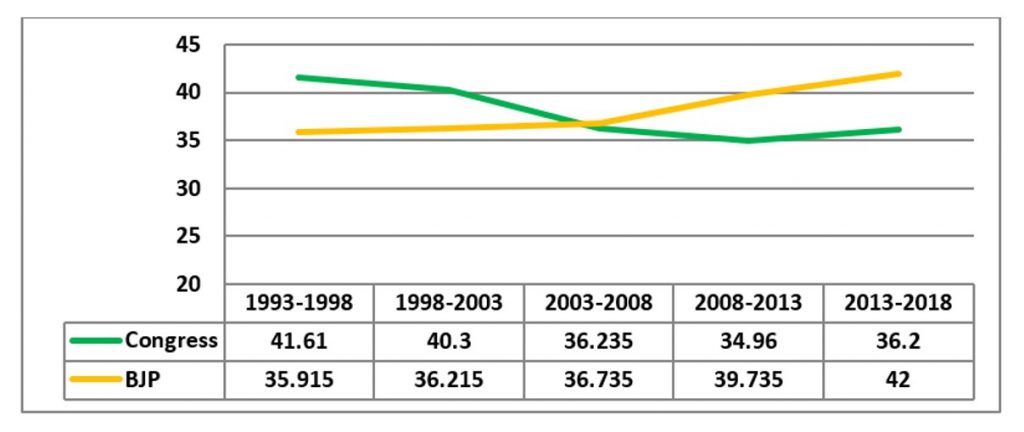
Here, the trend is pretty clear. BJP is growing consistently without hiccups in last 25 years mostly at the expense of Congress except in the last period, where Congress held on to its vote share largely at the cost of Others’ share.
Look at Table TR-5 and Chart CR-3 to understand the real lead of BJP over Congress after offsetting the impact of the inherent anti incumbency vote.

CR-3: BJP’s lead over Congress after offsetting the impact of anti-incumbency votes
Consistent gain in BJP’s lead over Congress’s core vote essentially means that the state has unmistakably moved towards saffronization.
1. Though, in keeping with the trend of the state, BJP has lost the state, the margin of loss has been negligible (0.5% as shown in Table TR-2) in a high Beta state. It implies that despite, alienation of a section of Rajputs (aka Karni Sena) and the perception of the outgoing CM VR Scindia being an arrogant CM, Rajasthan remains a big BJP stronghold and is moving quickly towards a 50+% vote share.
2. Taking this trend forward, it is very likely that when it will be BJP’s turn to lose vote share in 2028 after gaining it in 2023, its vote share will still be higher than Congress by a considerable margin of 3-4% , thereby retaining the state for a repeat term (something that AAIDMK did in Tamil Nadu 2016) and thus breaking the tradition of changing government every 5 years
However, it is always hazardous to mathematically extrapolate the electoral behavior which gets affected by the unforeseeable events.
Two important points besides the numerous unforeseeable ones, which have the potential to alter this forecast, are
1. Congress CM Ashok Gehlot (more so, the deputy CM Sachin Pilot) enjoys a good reputation and this factor might delay the saffronization (about 50% vote share for BJP for more than one term) of Rajasthan
2. 2018 is going to be an epochal event.
Madhya Pradesh
Though Congress has gained about 4% share in 2018 over its own 2013 vote share, its stills lags BJP vote share by 0.1%

CM-1: Vote Shares of BJP and Congress (in %age)
1. Even though BJP has lost some vote share, Congress victory has been largely because of others rallying behind it as others share has dropped drastically from near 30% to about 18% in a decade. (Table TM-3)
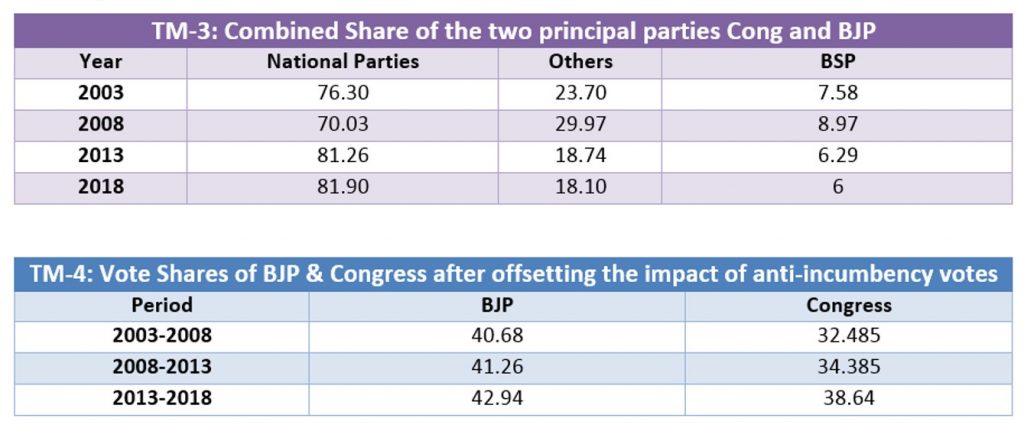
CM-2: Vote Shares after offsetting the impact of floating votes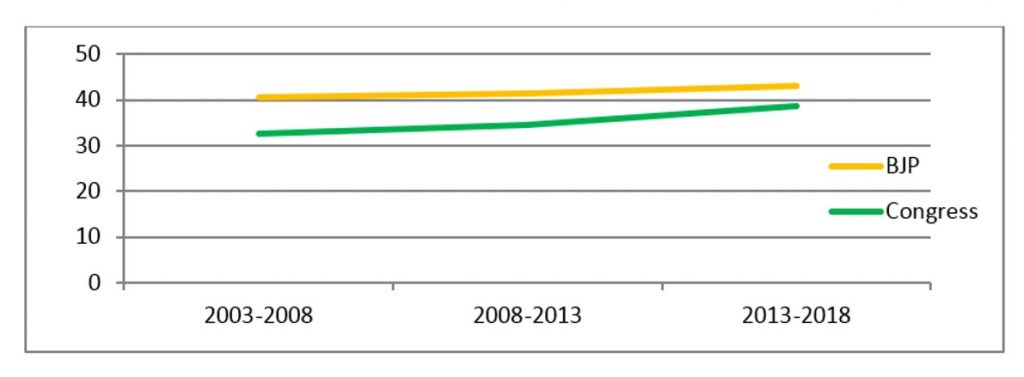
2. Marginal increase in vote share of Congress, despite the absence of any sign of unpopularity of the three-time CM Shivraj Chauhan and lack of any big issue can be attributed to silent muslim consolidation, Congress’s overtly hindutva campaigning and populist manifesto.
- BJP lulled in complacency because of lack of any overt muslim consolidation against it as usually happens in Hindi heartland (remember leaked video of Congress leader Kamal Nath urging Muslims behind closed doors to vote in large numbers)
- Overtly Hindutva (gaushalas etc) campaigning while cornering muslim votes only covertly behind doors might have resulted in a slight dent in BJP’s core votes.
- Populist manifesto (Loan waiver, unemployment allowance) by Congress seems to have succeeded in adding some non committed votes to its kitty taking it past the winning post.
3. BSP commands a very impressive 6-9% vote share (TM-3) though, largely concentrated in a particular region which can be overlooked by any strategist only at its own peril.
Being out of power after 15 years, without losing its vote shares, won’t necessarily be a bad thing for BJP. It might turn out to be blessing in disguise. Fourth successive victory could not have shaken a complacent party/leader to do something daring to take a big leap forward. A stint (it might not be 5 years long, could be only 12-18 months long or even less) outside power, if spent well, could catapult it to a position of invincibility with the core base of nearly 50%. (Even, a tiger takes a step back before taking a big leap)
The great Mauryan Empire needed not only Chankya and ChandraGupt Maurya but also a king like Dhananand to fructify. Time and circumstances seem to be ripe. Having a tainted CM like Kamal Nath with the wafer thin margin (in fact 0.1% vote less than the losing party BJP) could prove to be that very moment in BJP’s quest of weaving that impregnable 50%+ core base.
Chhattisgarh
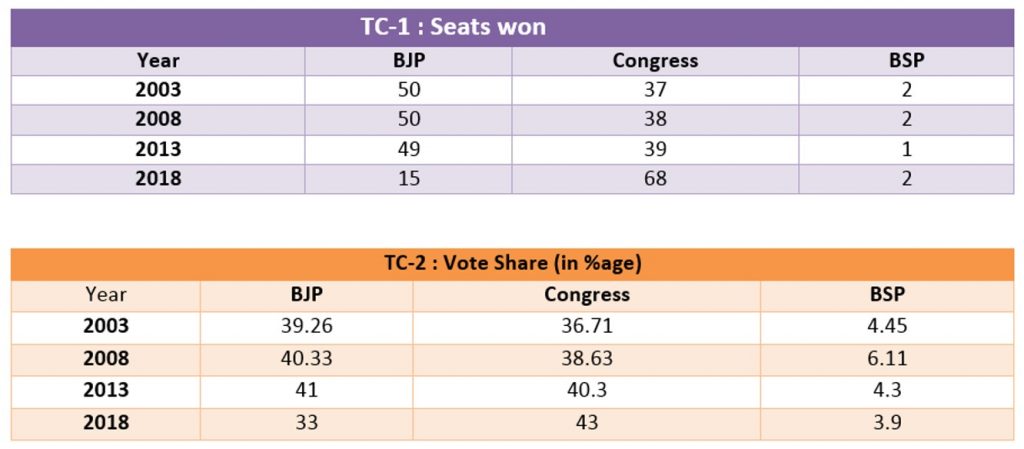
CC-1: Vote Shares of BJP and Congress (in %age)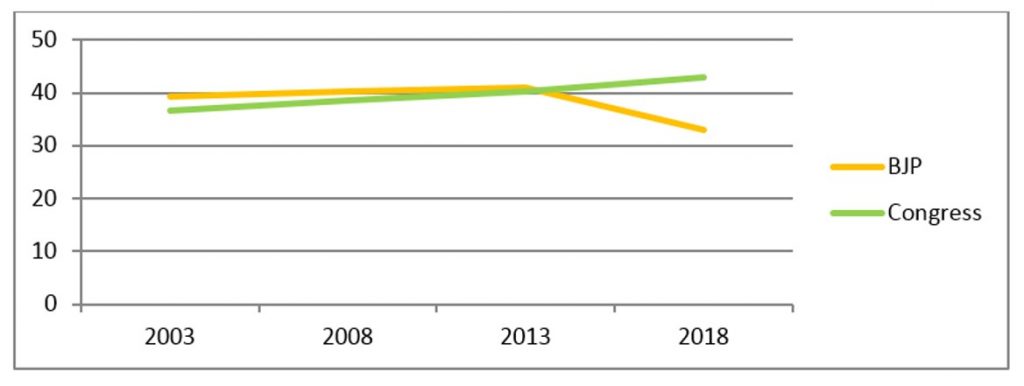
Both the parties had been locked in a tight contest for last 15 years. Though, BJP had been winning the state since 2003, its victory margin had been extremely thin (between 0.7%- 2.55%). (See Table TC-3). If despite that, BJP got to emerge victorious 3 times in a row, it was a case of its just being plain lucky.

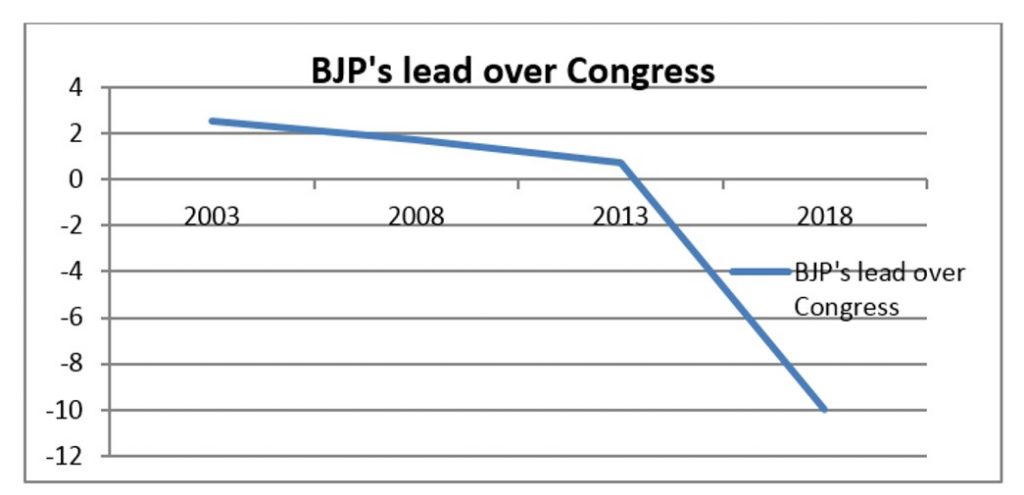 CC-2: BJP’s lead over Congress (in %age)
CC-2: BJP’s lead over Congress (in %age)
1. Ideally, these 3 successive wins should not have made any observer/analyst term Chhatisgarh a saffron state as BJP was gradually loosing the ground (Chart CC-2) before the big fall in 2018. However, most of them stayed oblivious of this fact and got carried by 3 time win eclipsing the hard reality about the extremely tight battle and started calling it a saffron state.
2. However, Congress strategists did not lose sight of that fact. They smelled the opportunity and scripted a wonderful victory while BJP seemed to have got lulled into complacency which made it lethargic/over-defensive to woo to new constituents to break out of the deadlock. Without any new community/group getting added to its kitty, BJP was fighting a losing battle (usual anti incumbency dictated the final verdict in the absence of any big issue).
3. Chhattisgarh (similarly, Jharkhand too) will remain a challenge for BJP in the years to come even if it manages to get re-elected next time (either by virtue of same usual anti incumbency against the new government, or some smart poll strategy or usual factionalism within the congress). It will need big efforts and a fresh approach to turn it around by creating a good base among tribals (the way it made itself the natural party of poor non Yadav OBCs in UP) before it could be termed a saffron state.
Impact on LS-2019
It was, and is still, widely believed that BJP will garner much more vote share in these 3 states (as in the rest of India) in LS2019 as compared to the state elections.
Prior to these elections, BJP was looking forward to a near clean sweep. However, after congress winning the mandate so close to the general elections, will mean that, now It (congress) will have an upper hand in Chhattisgarh and can very well hope to get some seats in the other two states as well (if it focuses on some selected seats and showers them with goodies) by virtue of having installed its own government
Author : Sunil Singla, IIM-A Alumnus, keen political watcher, can be reached on his twitter id @sunsin11

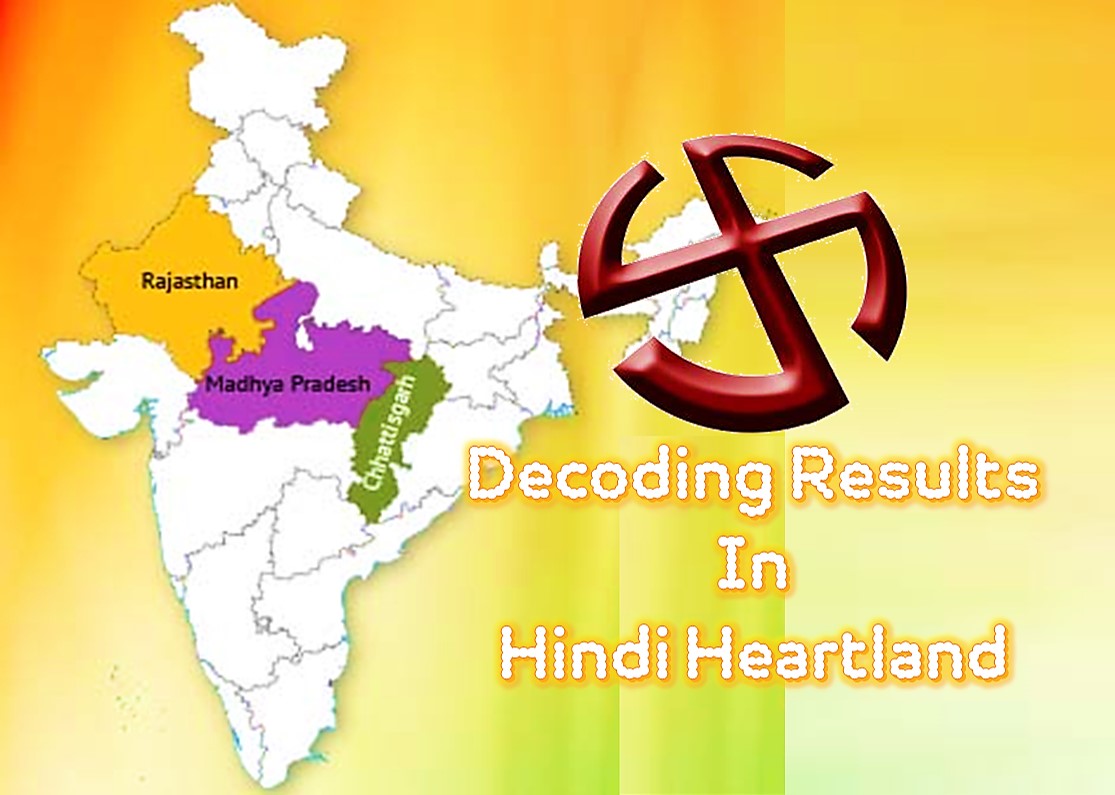
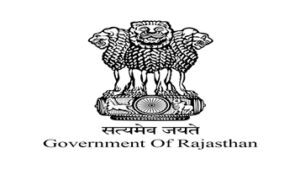

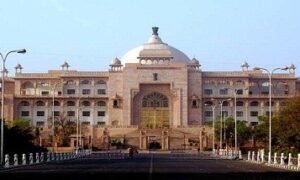

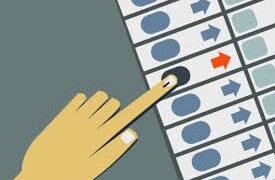









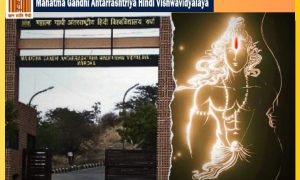



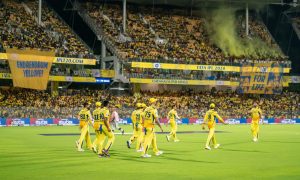

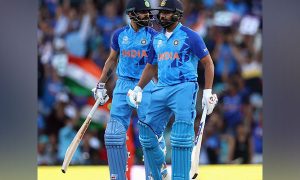

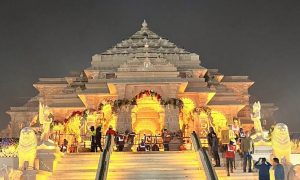

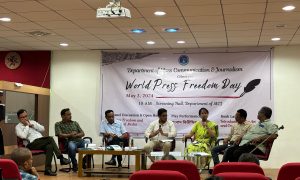

 WhatsApp us
WhatsApp us
Pingback: kahpe siteleri
Pingback: gppc reviews
Pingback: كلمات اغاني
Pingback: buy vapes online
Pingback: Fremont Street Hotels
Pingback: so de
Pingback: Sweet shop online
Pingback: How to join Bitcoin Era?
Pingback: azure devops
Pingback: fake audemars piguet royal oak offshore volcano
Pingback: Philips CD250 manuals
Pingback: 3M UY2-D manuals
Pingback: 메이저토토사이트
Pingback: Sebring Tow Truck
Pingback: Service Virtualization
Pingback: auto trading
Pingback: deep web search engine not evil link
Pingback: online marijuana dispensary home delivery
Pingback: buying weed online reviews
Pingback: swiss audemars piguet royal oak 15450st womens series 3
Pingback: wmodziesila.pl
Pingback: Anais's Chaturbate
Pingback: https://suzanneguillette.com/2022/05/13/how-long-does-it-take-to-form-ahabit/
Pingback: buy colt guns
Pingback: sbo
Pingback: stucco repair
Pingback: sbo
Pingback: ดูหนังใหม่
Pingback: passionsense.co.uk/hookups-co-uk/
Pingback: Golden teacher mushrooms for sale
Pingback: site dumps pin 2023
Pingback: Reba Fleurantin
Pingback: legal tryptamines for sale
Pingback: Kitten House for sale
Pingback: future university partners
Pingback: معايير الرعاية الصحية
Pingback: حياة مهنية ناجحة للخريجين
Pingback: MBA courses in Egypt
Pingback: تحويل قبول الطلاب إلى جامعة المستقبل
Pingback: Public Administration
Pingback: برامج الإقامة الخاصة بتقويم الأسنان
Pingback: Toxicology and Biochemistry
Pingback: علاج الاسنان بالمجان
Pingback: Oral biology and oral pathology department
Pingback: Faculty of Engineering and tecnology Contact
Pingback: teaching and student activities
Pingback: Leadership and Service
Pingback: information sysytem department
Pingback: faculty of engineering and technology
Pingback: Transcript requirements for future university
Pingback: https://www.kooky.domains/post/how-web3-domains-differ-from-traditional-domains
Pingback: https://www.kooky.domains/how-it-works
Pingback: ما هو افضل تخصص في ادارة الاعمال
Pingback: ما هو أهم هدف للعلوم السياسية
Pingback: الأخلاقيات المهنية
Pingback: كم نسبة القبول في كلية الصيدلة
Pingback: علم العقاقير والسموم
Pingback: Dental Fellowship Programs
Pingback: The main goal of the Faculty of Engineering is the Future University in Egypt
Pingback: الانسحاب والإضافة
Pingback: PHD dental in future university in egypt
Pingback: MBA in Future university in egypt
Pingback: Orthodontic Residency Programs
Pingback: Transfer students admissions to future university
Pingback: متطلبات كشف الدرجات لجامعة المستقبل
Pingback: Maillot de football
Pingback: Maillot de football
Pingback: Maillot de football
Pingback: Maillot de football
Pingback: Maillot de football
Pingback: SEOSolutionVIP Fiverr
Pingback: butterfly pecs
Pingback: Fiverr Earn
Pingback: Fiverr Earn
Pingback: Fiverr Earn
Pingback: Fiverr Earn
Pingback: Fiverr Earn
Pingback: fiverrearn.com
Pingback: fiverrearn.com
Pingback: fiverrearn.com
Pingback: ikaria juice
Pingback: red boost mediprime
Pingback: lilac french bulldog houston
Pingback: clothes manufacturer
Pingback: fiverrearn.com
Pingback: fiverrearn.com
Pingback: fiverrearn.com
Pingback: french bulldog
Pingback: fiverrearn.com
Pingback: fiverrearn.com
Pingback: french bulldog puppies san francisco
Pingback: frenchie red eyes
Pingback: dog breed
Pingback: vacation rental isla mujeres
Pingback: Professional Piano Disposal
Pingback: Best university in Egypt
Pingback: Best university in Egypt
Pingback: isla mujeres golf cart rental
Pingback: blockchain
Pingback: fresno california clima
Pingback: teacup french bulldog for sale
Pingback: french bulldogs for sale tx
Pingback: Pure copper ring
Pingback: future university
Pingback: future university
Pingback: future university
Pingback: aries medallion
Pingback: multisbo
Pingback: rent a golf cart isla mujeres
Pingback: frenchie puppies
Pingback: best university Egypt
Pingback: Piano disposal
Pingback: Piano tuning services
Pingback: Piano repair specialists
Pingback: Discreet moving
Pingback: Moving logistics
Pingback: Safe moving
Pingback: Future University business programs
Pingback: Classic Books 500
Pingback: FiverrEarn
Pingback: Speaker
Pingback: Media
Pingback: Porn Star in Australia
Pingback: Pupuk Anorganik terpercaya dan terbaik di pupukanorganik.com
Pingback: partners
Pingback: exipure official website
Pingback: supplement for sleep
Pingback: menorescue where to buy
Pingback: collagenius
Pingback: Social Justice
Pingback: live sex cams
Pingback: live sex cams
Pingback: live sex cams
Pingback: french bulldog breeders texas
Pingback: Private University Yemen
Pingback: Scientific Research
Pingback: Kuliah Termurah
Pingback: FiverrEarn
Pingback: FiverrEarn
Pingback: Generator sales Yorkshire
Pingback: live sex cams
Pingback: live sex cams
Pingback: rare breed-trigger
Pingback: 늑대닷컴
Pingback: Slot Yunani
Pingback: nang delivery
Pingback: freelance web developer Singapore
Pingback: allgame
Pingback: 918kiss
Pingback: หวย24
Pingback: Korean Skincare
Pingback: pg slot
Pingback: aplikasi slot online gampang jackpot
Pingback: resorts in the catskills new york
Pingback: 3 408 cheytac
Pingback: deux categorie de logiciel malveillants
Pingback: informatique dans le monde
Pingback: Skywhip tanks
Pingback: quick nangs delivery
Pingback: itsmasum.com
Pingback: itsmasum.com
Pingback: talk to people online
Pingback: tokyo jobs